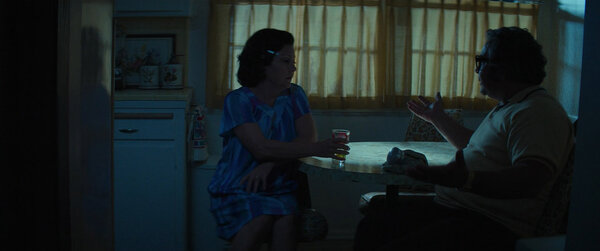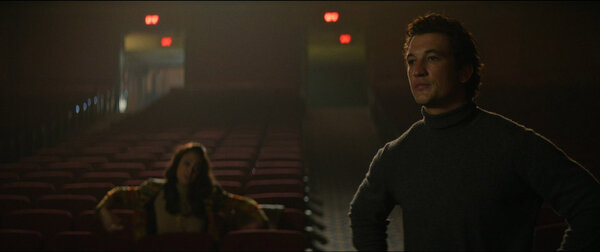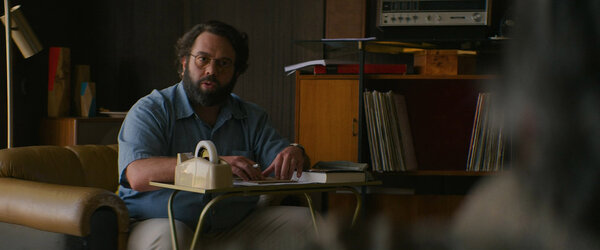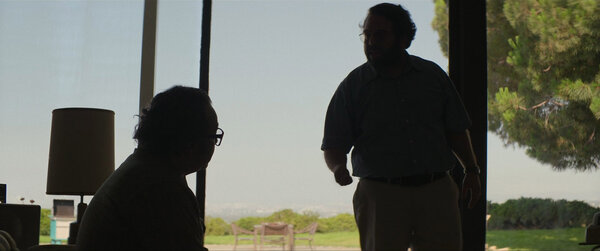Camerimage 2023
Salvatore Totino, ASC, AIC, talks about the shooting of the first six episodes of the series "The Offer"
The series you just couldn’t refuse, by François ReumontFor the first time in his long career, Italian-American cinematographer Salvatore Totino (Davinci Code, Everest...) was in charge of this series, and photographed the first six episodes. Three directors follow one another around him (Dexter Fletcher, Adam Arkin and Collin Bucksey). "The Offer" is competing for the Golden Frog for Best Series at Camerimage 2023. (FR)
Where did the idea for this miniseries come from ?
Salvatore Totino : The famed Al Ruddy, who produced The Godfather, came up with the project.
He is now 93, and much of the script came from his memoirs. Working with such a legend, on such an iconic subject... you can imagine the excitement that can bring as a filmmaker. However, this is not a series for film buffs alone, as some similar projects can be. On the contrary, it simply shows the general public just how difficult production can be, almost possibly fictional, and just how much persistence, talent and luck had to be mustered to make this film.
It’s such a brilliant film, you know. A film that completely renewed the genre and pushed so many boundaries - including the cinematography. Yet, few people really know what the protagonists had to go through to get there !
Around the character of Joe Colombo for example - for whom Giovanni Ribisi had to gain almost 20kg to play - a real gangster story is happening during the making of a film about gangsters. And it’s a true story ! At the time, Colombo and his son were on the FBI’s list, so he set up the Italian-American Rights League as a diversion. We can see how producing a film on the Italian mafia, right in the middle of New York, during that time was so difficult for Ruddy. It was very daring on his part ! I bet he didn’t really know what he was getting himself into....
When you think of The Godfather, you also think of Gordon Willis.. .
ST : Yes, a lot of people asked me if I was going to light the show like Gordon Willis did... But we didn’t want to copy Coppola’s film. It wasn’t a remake, but a new story based on the genesis of the film. Our challenge was to take the viewer on a journey through time and events, and to bring to life this whole cast of incredible characters. The series’s visual style is therefore very different. For example, we chose anamorphic, which is very different from the 1.85 used on The Godfather. Our choice of digital, with the Sony Venice in 4K and the way we managed the lighting from episode to episode was also very different. The main challenge for me was shooting in Los Angeles, trying to recreate all the scenes there that were supposed to take place in New York. For example, the façade and exteriors of Joe Colombo’s social club were reconstituted on Universal’s backlot. If, like me, you’re very familiar with the Little Italy district in which the action is supposed to take place, it’s really difficult when you arrive on this redesigned street corner to feel like you’re there... we really had to push with the whole team, particularly the special effects, to extend the perspectives and make it believable.
The other big difficulty was natural lighting : reproducing that ’architectural canyon’ feeling you get in New York is really not easy in California. We had to push the boundaries with our team, and build as many structures as possible to get that sensation back into the image.
Finally, and this is also particular to series - something I’ve never had to deal with before - we were working with different directors every two episodes or so.
As the sets themselves came back regularly with each episode, the cost of tying up all these sets became prohibitive. Whereas on a feature-length film, for example, the shoot happens for a fortnight on the same set, grouping all the scenes in the same place, here, having multiple directors often made cross-boarding impossible. For me, this was a real waste of money that could have been going towards the visuals. Having only two directors on the series would make it possible to group things together, and save a lot of money. The first five episodes could be planned just like for a big film, and then the same thing with the next five.
How long did you shoot for ?
ST : For the six episodes I was in charge of, we filmed for about four months, between July and October 2021. There was a break during the shoot at the end of July because Miles Teller, who plays Al Ruddy, had caught Covid, which gave us about ten days to prepare for the arrival of the second director on episodes three and four. It was fortunate in a way, because it allowed us to make a smooth transition.
Let’s get into the details, and talk about some of the scenes in the first episodes… For example, the night sequence in episode 1 between Mario and his wife...
ST : This scene represents a moment of despair for Mario Puzo’s character. He’s just been mugged in the street by someone to whom he owes money, and you can tell he’s hitting rock bottom at the beginning of the story. His latest book is a flop, and he is taking stock of the situation with his wife in their kitchen. It’s a scene where he confides in her, deliberately chosen to take place at night, with a very sombre tone. He comes home, ashamed by his secrets, and opens up about the failures in his life. It’s also a moment when we discover that his wife is going to play an important role in his creative decision to write his new novel - "The Godfather".

They’re sitting in this little kitchen, a natural set that we found in the San Fernando Valley, which hadn’t really changed since the 60s. The scene had to be shot during the day, so I had a blackout tent built outside to block out the light. I really like this intimate moment between these two characters, with the reflection of Mario’s silhouette on the fridge on the left. It’s a bit like his ghost watching him, or his psychoanalytical alter ego... for his close-up, I really wanted him stand out from the rest of the image, because his face is very dark and so is the background. But I didn’t want to use backlighting, as is traditional in a night sequence in cinema. That’s why I lit the room behind him very lightly. It was a sort of laundry room where you can make out the washing machine and the door that might lead into the garden. It’s a slightly warm atmosphere that contrasts with the very blue-green atmosphere in the kitchen. It was a way of showing through the visual that he’s a nice guy...

And that even though what he’s going through in life is very hard, this warmth is there to make him quite likeable. With the idea of making things realistic. Exactly what well-tuned backlighting isn’t. Even if it’s unconscious for the cinematographer and to the viewer, I think everyone feels this.
The second sequence, with Ruddy (Miles Teller) and his French companion (Nora Arnezeder) in a cinema...
ST : As the credits roll, our two characters (Ruddy and Françoise) remain seated in the room, until they are the only ones left in the cinema. That’s when he suddenly realises that he doesn’t want to hear any more about his past life as a computer programmer, or even as a TV scriptwriter (he’s just launched his career with the creation of the hit series "Papa Schultz"). A scene in which the setting plays a big part in his decision to go into film. Fortunately, Los Angeles still has a few natural settings like this one. Places that date back to the 30s, and where all the magic of the show is created by the setting. To create this scene’s visual, I used all the existing sconces and lights that you see on the balcony. It creates a very warm atmosphere, which for me is like a rebirth, a moment when he realises who he really is.

For the cutting, it’s fairly representative of what I developed over the whole series, namely working with two cameras, trying to cover as much of the scene as possible from two points of view. It’s a decision that’s usually taken when you’re setting up the scene with the actors, and it’s amazing how you always manage to find something special with the second camera. Something that you wouldn’t have anticipated, that the actors themselves wouldn’t necessarily have given to a single camera in their performance. For example, when you do a shot-reverse shot with a single camera, and the actor who’s off-camera just gives the line without acting and giving his all. It’s a method that really changes a lot of things on set.
And the flares... they show up on the image in the series...
ST : I find them very natural ! For this series I used the Hawk V-Lite anamorphic series, which works very well for this type of lighting. The flares aren’t present in every scene, but when they are, I think it reinforces the realism we were talking about earlier. It breaks the ’perfect image’, because we all know that the real world is never perfect. In this wide angle shot, for example, it’s a simple PAR 64 placed to one side, which gives this little flare, in addition to a bit of smoke we’d created in the cinema.

And the third sequence, when Mario Puzo and Francis Ford Coppola are writing the script. With Coppola who’s just been hired to assist him...
ST : That’s a sequence we really enjoyed shooting. We had so much fun ! These two characters are priceless, and the two actors had a ball. Here again we were shooting in a natural setting, a house furnished entirely in the 60s style, with the swimming pool and beautiful view. It was a little hideaway that we’d found so that they could write in peace, and which became a pretext to say to the viewer : "These two guys are going to take over the town !”


It’s always very important for me that the viewer gets a sense of the setting of each scene, in addition to the acting. It was the reveal that was important, and that’s why we took the liberty to use total backlight for this scene, when Mario Puzo and Francis Ford Coppola are in front of the big window, revealing the full view of the city. In this scene, Los Angeles was the third character.
I realised that the series works a lot around character duos. Ruddy and Francoise, Puzo and Coppola, Evans and Bludhorn, or Colombo and Gallo ....
Fourth sequence, a discreet meeting with the highest ranks of the mafia between Colombo (Giovanni Ribisi) and Gambino (Anthony Skordi).
ST : If you look closely, this sequence is not at all like in The Godfather. The light comes from outside ! It’s not at all like the skylight Willis used. I was trying to create a more realistic style. Maybe it’s also an atmosphere that reminds me of my childhood. I remember that at the time, during the day, we hardly turned on the lights in the house. Just to save electricity, which already cost a fortune at the time. That’s exactly the atmosphere I had in my parents’ living room, quite dark, with the light coming mainly from the windows when it was sunny outside. For the choice of lenses for this scene, the idea was to get close enough to the faces, while maintaining an external shot-reverse shot value. That way the presence and symbolic weight of each actor is there. When you get that close to faces in a scene, you’re conveying a message to the viewer. The solemnity and seriousness of what is being said can be felt immediately through the image.

Which lights did you use ?
ST : If I remember correctly, I installed 12kW MolePARs (110v) behind the windows. Tungsten again, very classic. That didn’t stop me from using LEDs in other scenes, but in this case I think that the frontal aspect and simplicity of these sources was the most appropriate. Finding a balance between the practical side of LEDs, -in terms of adjusting intensity or colorimetry-, with the visual style you want. Working with tungsten is more restrictive, slower and requires more effort... but admittedly the result is not the same as with LEDs... I see myself kind of like a dentist, or a mechanic on a set. I choose the tool that works best depending on the context.
(Interview by François Reumont, translated from French by Chloé Finch, for the AFC)
 En
En Fr
Fr






